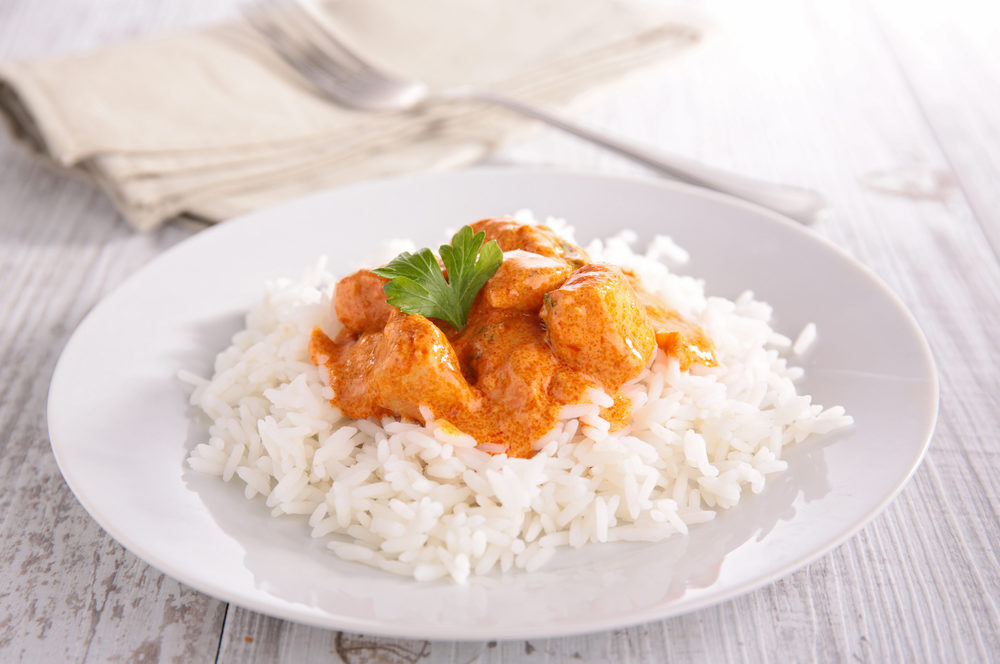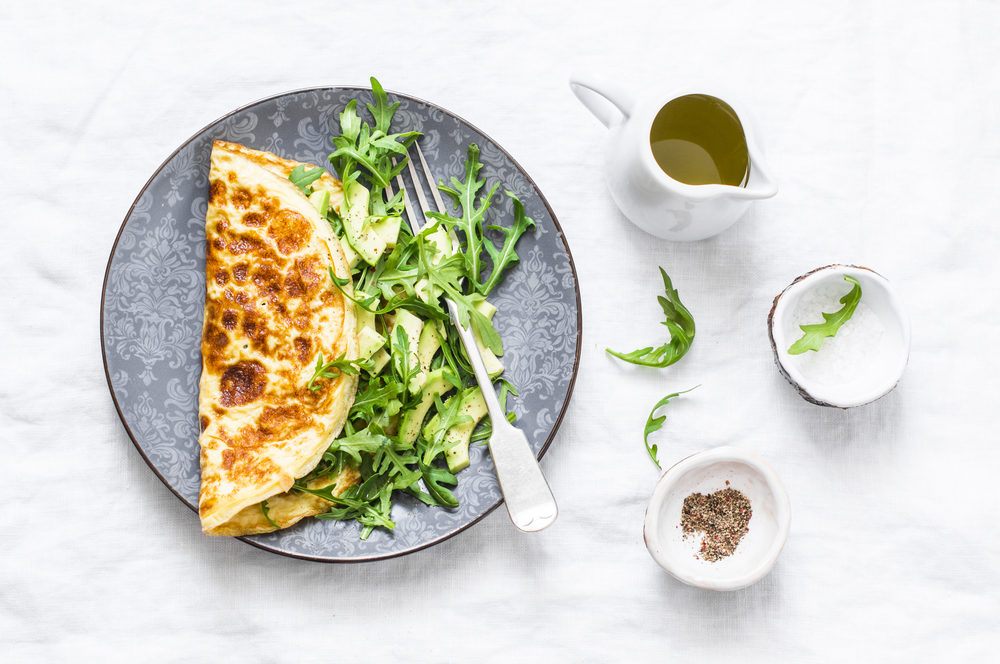Is there anything possibly more satisfying than a great butter chicken spread over basmati rice? (Besides a good chardonnay to go with it). My kids adore Indian butter chicken, and you can vary the degree of spice based on your taste (and their tolerance!). The list of ingredients may be long, but check out the 2-step directions. Complex flavours and easy assembly. We heart you, slow cooker butter chicken. Sorry, but we can’t help with the pakoras.
 I made this slow cooker lasagna recipe with the kids and claimed back tons of time for play as it bubbled away for 6 hours. The hard noodles softened and I actually found the end result to be more firm and flavourful than my Mom’s more labour-intensive version! Plus, the hidden quinoa and fresh herbs make it much healthier. You may find some Walmart slow cookers at a good price.
I made this slow cooker lasagna recipe with the kids and claimed back tons of time for play as it bubbled away for 6 hours. The hard noodles softened and I actually found the end result to be more firm and flavourful than my Mom’s more labour-intensive version! Plus, the hidden quinoa and fresh herbs make it much healthier. You may find some Walmart slow cookers at a good price.
Ingredients:
1/2 pound ground beef
1/2 pound ground sausage, pork or chicken (you could also do a vegetarian/tofu meat substitute)
1 medium onion, chopped (1/2 cup)
3 cans (15 ounces each) Italian-style tomato sauce
2 teaspoons dried basil leaves
2 teaspoons oregano
2 teaspoons thyme
1/2 teaspoon salt
2 cups shredded mozzarella cheese (8 ounces)
1 container (15 ounces) part-skim ricotta cheese
1 cup grated Parmesan cheese
15 uncooked lasagna noodles
3/4 cup dry quinoa
chopped parsley
1. Cook the meat and onion in 10-inch skillet over medium heat 6 to 8 minutes, stirring occasionally; drain. Stir in tomato sauce, herbs and salt.
2. Mix 1 cup of the mozzarella cheese and the ricotta and Parmesan cheeses. (Refrigerate remaining mozzarella cheese while lasagna cooks.)
3. Spoon one-fourth of the meat mixture into 6-quart slow cooker; top with 5 noodles, broken into pieces to fit. Spread with half of the cheese mixture and one-fourth of the meat mixture. Top with 5 noodles, remaining cheese mixture, a layer of quinoa and one-fourth of the sausage mixture. Top with remaining 5 noodles and remaining sausage mixture.
4. Cover and cook on Low heat setting 4 to 6 hours or until noodles are tender.
5. Sprinkle top of lasagna with remaining 1 cup mozzarella cheese. Cover and let stand about 10 minutes or until cheese is melted. Broil on low in the oven (optional) for 5 minutes. Sprinkle chopped parsley on top. Cut into pieces.
 Looking for an easy, tasty recipe for a romantic dinner? This super simple meal has a fancy feel without the “fancy” work. Enjoy bacon-wrapped pork with bok choi at home on a blustery night when the kids are at the grandparents. You can find some great ingredients using Meijer coupon codes.
Looking for an easy, tasty recipe for a romantic dinner? This super simple meal has a fancy feel without the “fancy” work. Enjoy bacon-wrapped pork with bok choi at home on a blustery night when the kids are at the grandparents. You can find some great ingredients using Meijer coupon codes.
Ingredients:
1 lb pork tenderloin
1 tbsp vegetable oil
8-10 slices of bacon
8 cups of baby bok choy, sliced in half length wise and washed
1 bottle of VH Sweet and Sour Sauce
Heat oven to 400F (200C), slice tenderloin into 2 pieces. Heat oil in a large sauté pan over medium-high, brown the pork about 7 minutes. Layer 4-5 bacon slices by side on a cutting board, allow edges to only slightly overlap. Place one piece of pork across the bottom ends of the bacon strips, roll the bacon around the tenderloin and place the wrapped pork seam side down in a baking dish. Repeat with second piece and remaining bacon. Place baking dish in oven and cook until bacon is browned and pork is cooked through, about 30 minutes (pork should be cooked to an internal temperature of 160F (70C)). Pour out leftover oil from sauté pan, add baby bok choy and 2 tbsp (30 mL) water, cover and cook on medium heat for 8 minutes, add bottle of VH Sweet and Sour Sauce and heat through, lower heat to simmer and keep warm. When pork is ready, slice and serve with bok choy and VH Sweet and Sour Sauce.
 Picture this. London, 2011. A big boardroom full of Cargill Employees, the Canadian Food Inspection Agency (CFIA), McDonald’s employees, and 4 absolutely stiff, petrified Moms. And a baby (Mo is so devoted her 3 week-old joined us). We knew how these things worked by now and how this tour would go…. coffee, an intense 3-hour crash course about the industry and how the facility is run, with farming fodder thrown-in and tweets being answered at the same time. Then a lunch. And then. Gasp. A plant tour. (You thought the gasp was for the crazy helmets, lab coats, safety goggles and hairnets, didn’t you?) Unlike our beef and potato plant tours, however, for this tour we were slated to see the… I have trouble saying it. The point at which an alive chicken becomes a not-alive chicken. We were terrified. Why don’t I start at the beginning, though. The chicken. No. The egg. Snicker. (See – I use humour when I’m not quite comfortable).
Picture this. London, 2011. A big boardroom full of Cargill Employees, the Canadian Food Inspection Agency (CFIA), McDonald’s employees, and 4 absolutely stiff, petrified Moms. And a baby (Mo is so devoted her 3 week-old joined us). We knew how these things worked by now and how this tour would go…. coffee, an intense 3-hour crash course about the industry and how the facility is run, with farming fodder thrown-in and tweets being answered at the same time. Then a lunch. And then. Gasp. A plant tour. (You thought the gasp was for the crazy helmets, lab coats, safety goggles and hairnets, didn’t you?) Unlike our beef and potato plant tours, however, for this tour we were slated to see the… I have trouble saying it. The point at which an alive chicken becomes a not-alive chicken. We were terrified. Why don’t I start at the beginning, though. The chicken. No. The egg. Snicker. (See – I use humour when I’m not quite comfortable).
From Egg to Chicken:
The eggs are collected daily from the farms and transported to a hatchery where they are incubated for 19 days. A ‘setter’ constantly turns the eggs to keep them warm and provides a simulation similar to a mother hen sitting on top of them. That revelation kind of validated my role as a mother. Kind of. In a George Orwell kind of way. At the 19-day mark, the eggs are vaccinated and transferred to hatch baskets where they will hatch within 2 days. Once hatched, the chicks are separated from the eggshells and transferred to chicken farms until market age (40-45 days old).
From Chicken to Egg:
I’m completely convinced after meeting the farming experts, regulators, and Cargill employees, that care for the animals really is paramount. Cargill deals with 140 chicken farms and all must meet very rigorous standards as specified by McDonald’s. In Canada, the family farm model is the norm. Having farmers own and care for their chickens until the point at which they are transported from the farm for processing helps ensure the quality and integrity of the farm.
The barns are kept at 28 – 32 degrees celsius and the chickens roam around on shavings. They always have access to feed and water and are free to roam within the barn. Federal regulations in Canada recommend that no more chickens can be in a barn than 31 kilos per meter square. Farm managers and their staff visit the barn throughout the day.
For all of you who are going to ask about ‘free range’ in the barns, the chickens in these barns are just meat birds (broiler chickens). These are very different than egg layers. The broiler chickens are kept in barns to ensure food safety. If these meat birds were outside they would be more susceptible to disease.
Advances in feed for the birds mean that currently, 2 pounds of grain fed to a chicken will produce 1 pound of chicken. The feed is 88 percent grain, 10 percent protein, and 1-2 percent vitamin supplements.
All catchers and drivers are trained in animal welfare practices and as of July 1, 2011, a person must be specially licensed to transport chickens. The live birds are put into crates and the birds must be able to move comfortably. They are on the trucks only 4-8 hours, as most farms are within an hour or 2 of the London Cargill plant. During the warm summer months, the birds are misted to keep them more comfortable in the heat.
From Alive Chicken to Not-Alive Chicken:
In the Cargill plant, 3,200 different food safety and quality checks occur on a daily basis. There are even 2 X-ray machines that detects residual bones or foreign material – and the chicken meat passes through 2-3 times!
I was shocked to hear that 80-90,000 chickens are processed daily. 900 people work at the plant, and only 3 per cent leave the facility each year. Cargill boasts one of the lowest turnover rates for the meat industry in the world.
The facility is separated into the raw chicken processing part and the food manufacturing part. For food safety reasons, employees wash their hands and go through a boot sanitizer and, in addition to regular cleaning, the entire plant is completely cleaned and disinfected nightly by 60 people – like the inside of a dishwasher. I wish my house had that capability.
When the live chickens come into the plant, they are removed from the truck by a human being on a scissor lift to ensure that the employee is at the same level as the crates. This is better for people, to help avoid back problems, as well as the chickens.
In the slaughter area, everyone was so calm and peaceful I didn’t know where I was until it was pointed out to me. It wasn’t what I was expecting. It was very dark, with a blue light shining. As per Temple Grandin’s recommendations on animal welfare (link to beef post), the facility has been audited and Temple Grandin has approved of the process itself. In addition, blue lights are used because birds can’t see the colour blue so it appears dark. They are hung by the ankles, a plate or bar rubs the breast of the bird and they hang touching each other, shoulder to shoulder. I witnessed first-hand how calm this makes the birds. They are not flapping or making noise. They travel on a rounded track and are dipped quickly in water where an electrical stun renders the chicken insensible to pain, which means they are unconscious and alive but do not feel any pain. Their necks are cut and the bleed-out occurs while the chicken is unconscious so they are dead before they wake.
To remove the feathers, the birds go through a hot water bath and pickers – rubber fingers – massage the bird and take out feathers. The head and feet are removed and a machine removes the organs, transferring the viscera to a separate line. The organs and bird are kept together for inspection so that if the inspector and vet condemn a bird, the whole bird will be disposed of – again for food safety. Fifteen federal inspectors, including four CFIA vets work at the London facility. Once the chicken and organs have been inspected and approved, the meat moves on to food processing. Every part of the chicken has a use. The organs are used for pet food and animal feed, while the blood, feathers and offals are sold to a rendering company that makes ingredients for animal feeds, fertilizers and markets such as cosmetics, rubber and explosives.
The bird is placed in a chilling tank for 1 hour and must cool to less than 4 degrees Celsius in order to debone, which means to remove the bones from the meat. Chlorine is present in the chiller for sanitation purposes, much like a swimming pool. Levels are monitored every hour. At this point, an antimicrobial treatment is applied. It is cetylpyridinium chloride – the same substance contained in mouthwash. This is an opportunity to reduce salmonella. The bird is then rinsed. For the record, this is when I relaxed significantly. I was now looking at chickens like I’d buy in a supermarket.
75 per cent of the original bird goes into debone process, and I was shocked at the number of people working together to debone the chickens. By hand. Seriously. Wow. There is no mechanically separated meat in McDonald’s products. The frames of the chicken that are left at the end of the process get sent to another facility for people who use mechanically separated meat for hotdogs and other products.
The Making of McNuggets:
The white breast meat, along with chicken stock and a natural proportion of skin from the breast is placed into a huge blender. I didn’t realize that there is skin in the nugget mixture but this helps to hold the shape. The meat is then mixed and chilled using CO2. McNuggets are formed, not ground. There are 4 shapes that are pressed out with a rolling cookie cutter: boot, bow-tie, ball and bell. The reason they are all standard in shape and size is to ensure consistency in all McDonald’s restaurants. This guarantees both food safety (standard cooking times in restaurants) and portion control.
Once the fun shapes pop out, they are coated in batter, dusted with flour and then given a final coat of tempura batter. Who knew? From here they are par-fried and placed directly into the freezer. A thin mist of water is sprayed onto them, as tempura is susceptible to dehydration. They are then inspected and packaged to be sent off to the restaurants.
Grilled Chicken:
We also witnessed the grilled chicken being made. It’s pretty simple – it’s just one huge hunk of breast meat but a laser-guided water jet cutter trims it to an exact size. Very James Bond.
In all, I will still eat chicken. I will still eat McNuggets. I’m satisfied with the animal treatment and food safety. I think I’ll stick with the grilled chicken in snack wraps and sandwiches, as there are fewer ingredients, but the nuggets sure are yummy! For the other All-Access blogs please click here, or to see the UrbanMommies Q and A, click here.
 As with every All-Access trip, our published polls readers for questions and has promised to find the answers. Here they are!
As with every All-Access trip, our published polls readers for questions and has promised to find the answers. Here they are!
Q: What about vaccines, antibiotics and hormones used in chicken products?
A: Vaccines are administered once throughout the chickens’ life to prevent the birds from dying of diseases and improve the health of the whole flock. In order to feed millions of people and remove undue suffering of the animals, McDonald’s and Cargill’s policy is to vaccinate. Antibiotics are only given if a bird tests positive for illness, which would put the entire flock at risk. Antibiotics require a vet prescription and a strict withdrawal period is adhered to before the chicken is turned into food to ensure that no residual medications are present in the product.
McDonald’s has a global antibiotic policy. It is a policy that has been developed with the assistance of scientists and industry experts. Given that McDonald’s is required to process 90,000 birds per day in Canada alone to feed its customers, the company has a keen interest in making sure the industry is sustainable. The pre-emptive use of antibiotics is not allowed, nor does it allow sub-therapeutic use. Even the feedmills that produce the grains fed to chickens have to be accredited and constantly audited.
Hormones are illegal in Canada for use in chicken and in dairy. This is due to the withdrawal period that is required. There is not enough time for hormone elimination in milk and chickens. That’s why there are no hormones allowed. Beef has more time in withdrawal period and is therefore acceptable to use hormones before it is processed for meat production.
Q: People have asked me why there are so many ingredients in McNuggets and why the ingredients are so chemical-sounding?
A: McDonald’s is very careful about listing ingredients for allergy reasons and ingredients that could be bundled together are separated out to help people who may have an allergy. Chemical names are used which might sound more complicated than they are (they say sodium bicarbonate instead baking soda, for instance).
For the full post on chicken please chick here.
The proper nutrition and the right diet are key to having a good supply of nourishing milk. Nursing is no time to diet or skimp on nutrients. Eat plenty health-promoting fats from foods like free range eggs, organic whipping cream, organic butter & avocado as breast milk is largely composed of fat. Our nursing omelet is a perfect way to tick all of the boxes.
 Recipe courtesy Chef Jon-Paul Hutchins, Scottsdale Culinary Institute
Recipe courtesy Chef Jon-Paul Hutchins, Scottsdale Culinary Institute
Polenta:
4 cups chicken stock
4 tablespoons butter
2 teaspoons ground black pepper
1 tablespoon salt
2 cups polenta or cornmeal
1/2 cup grated Parmesan
1/2 cup finely shredded basil leaves
Softened butter for the pan
Olive oil, as needed
Marinade and Vegetables:
1/4 cup balsamic vinegar
1 clove garlic, minced
3/4 cup olive oil
Salt and pepper
2 red onions, cut into 1/2-inch thick slices
2 zucchini, cut into 1/2-inch thick slices on the diagonal
2 yellow squash, cut into 1/2-inch thick slices on the diagonal
2 red bell peppers, cored, seeded, and cut into 2-inch pieces
1/2 pound asparagus, tough ends removed
1/2 pound mushrooms
Make the Polenta:
Bring the chicken stock, butter, pepper, and salt to a boil in a heavy-bottomed pot. While whisking the hot stock in a quick circular motion, “rain” in the polenta by letting it stream through your fingers. (This will prevent lumping.)
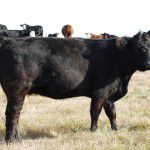 As many of our readers know, our publisher was chosen as a McDonald’s All-Access Mom, to see behind the scenes at McDonald’s Canada. Yes, the experience included meeting and moo-ing at a bunch of cows, as well as a potato farm, chicken plant, restaurant visit, Hamburger University and head office. As part of a promise to answer all of our readers’ questions, we’re publishing a Q and A for each trip. Here’s the beef. (More beef jokes in the main article on the trip).
As many of our readers know, our publisher was chosen as a McDonald’s All-Access Mom, to see behind the scenes at McDonald’s Canada. Yes, the experience included meeting and moo-ing at a bunch of cows, as well as a potato farm, chicken plant, restaurant visit, Hamburger University and head office. As part of a promise to answer all of our readers’ questions, we’re publishing a Q and A for each trip. Here’s the beef. (More beef jokes in the main article on the trip).
Q. Do they use hormones in what the cattle are fed?
A. Some farmers decide to use hormonal growth proponents and this is a business decision. For the farmers, there are costs associated with the hormones, and they must weigh the cost/benefit for their business.
Q. What are hormonal growth promotants?
A. Hormonal growth promotants are in the form of naturally occurring sex hormones which are administered to animals in order to improve an animal’s ability to use nutrients efficiently. Health Canada has approved three natural hormones and three synthetically produced hormones for use in cattle in Canada.
Q. What benefit is there to using hormones?
A. When these are used, the animal uses its feed much more efficiently. This means that the meat will contain more lean meat and less fat in the end. There can be more growth using less feed, resulting in less expensive beef for the consumer.
Q. How does the Canadian Government monitor the use of growth hormones?
A. In addition to the strict requirements which must be met in order to obtain approval to sell, and to use, growth promoting hormones in Canada, Canada’s national food safety agency, the Canadian Food Inspection Agency (CFIA), conducts regular monitoring programs in which thousands of samples of all meat products are analyzed to ensure that any drug residues which remain in meat are well within lawful, and safe, limits. Results of these monitoring programs are published regularly by the CFIA. Since residue levels of the natural hormones in beef are in the same range in both treated and untreated animals, Canadian regulatory authorities have concluded that it is not necessary to establish so-called safe limits of the natural hormones. CFIA monitors for residues of the synthetic hormones and Canadian regulations do not permit residues of any of the synthetic hormones to be present in meat. And year after year, Canadian beef has been in virtually 100 per cent compliance, that is, there are no residues in the beef.
Q. What about bacteria, Mad Cow Disease (BSE) and E. coli?
A. BSE control and testing happens both on the farm (sick-looking animals are isolated and tested) as well as at McDonald’s-approved primary meat processing (ie. slaughterhouse) suppliers. Canada does 40 times more than the global standard in terms of BSE prevention. Now, feed bans exist where the food chain is even more protected from contamination. Recent cases of BSE existed in older animals that were alive prior to the feed ban. In the last 3 years, there have been more than 100,000 animals tested with only 3 positives.
Beef is tested for E. coli 0157:H7 before it arrives at the facility. Any beef that tests positive for E. coli 0157:H7 never goes back into the McDonald’s food chain. In addition, the Cargill facility tests the incoming beef again for 0157:H7 as well as other types of bacteria according to the McDonald’s food safety standards. Quality checks and tests are also done on the finished patties. Test results on every batch of patties are seen prior to any box being released via the distribution networks.
Q. How do you make sure employees don’t lose their temper with animals at all stages of the process?
A. The CFIA has a Code of Practice related to animal welfare. In addition, there is a certified livestock transport program created by the Alberta Farm association to ensure humane treatment of animals. At the primary processing facilities, everyone who works there all go through animal welfare training. There is 3rd party video monitoring at all primary processing facilities. This technology can detect sharp movements and employees are always held accountable. If any facility ever fails an audit, McDonald’s may disapprove them as a supplier of beef.
Q. Is meat washed with ammonia?
A. No. Ammonia is only present within the refrigeration system to cool down the meat and never comes into contact with the meat itself. The refrigeration system used to run on Freon and it is now run on ammonia.
For our publisher’s full article on McDonald’s beef, please see the All-Access Microsite.
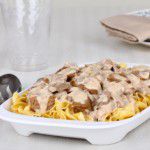 Remember the 70’s? Stroganoff and egg noodles, baby! Prepare this one while listening to disco, and make sure you explain 70’s fashion to your kids. (With the intention of them never wanting to wear bell bottoms or anything orange and brown.) Don’t worry. We won’t ever share recipes involving sweet potatoes and marshmallows.
Remember the 70’s? Stroganoff and egg noodles, baby! Prepare this one while listening to disco, and make sure you explain 70’s fashion to your kids. (With the intention of them never wanting to wear bell bottoms or anything orange and brown.) Don’t worry. We won’t ever share recipes involving sweet potatoes and marshmallows.
Sear the stewing steak (brown it in a pan). Remove from pan. Sautee chopped onion and sliced green and red peppers (and mushrooms if you like). Once onions transluscent, return beef to pot. Add 1 T. paprika, 1 T. mustard (dijon), 2 pints (cans) of ale (best are cream ales like Kilkenny, Caffreys, Boddingtons) and 1 pint beef stock. Bring to boil. Add a few dashes of Worcestershire sauce, salt and pepper. Reduce to very low heat. Add in sliced mushrooms, and optional: tomato puree (1 can). Simmer 2 hours (until it tastes sweet), remove lid to reduce sauce to desired consistency. Just before serving, you may optionally add 1 cup whipping cream. Serve over tagliatelle or rice.
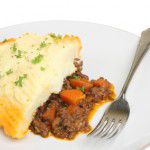 Apparently since 1885 in England, when the first mention of this dish hit literature, Ale Cottage Pie has been used to describe a beef dish covered in potato, whereas Shepherd’s Pie would contain lamb instead. (Shepherds care for sheep, not cattle). The addition of a dark ale enhances the flavours and adds depth to this simple, kid-friendly dish.
Apparently since 1885 in England, when the first mention of this dish hit literature, Ale Cottage Pie has been used to describe a beef dish covered in potato, whereas Shepherd’s Pie would contain lamb instead. (Shepherds care for sheep, not cattle). The addition of a dark ale enhances the flavours and adds depth to this simple, kid-friendly dish.
Sautee a diced onion and garlic until translucent. Add ground beef. Add salt and pepper to taste. Brown the meat. Drain fat off. Return to pan. Continue to brown. Add mustard ( 2T) and dashes of worstershire sauce.. Put in 2 pints of beer, 1 pint water (beef stock), bring to boil. REduce heat. Simmer, uncovered. Allow to reduce down at least an hour at a simmer. Transfer to Shephard’s Pie dish. Allow to cool. Add mashed potato. While boiling, put whole garlic cloves in the water – garlic will turn sweet when you boil. Add Salt, pepper, grated parmesan, butter and cream. Sprinkle salt on top. Score with fork. Bake in oven at 400 degrees for 30-40 mins until golden brown. Rest 10 minutes.

